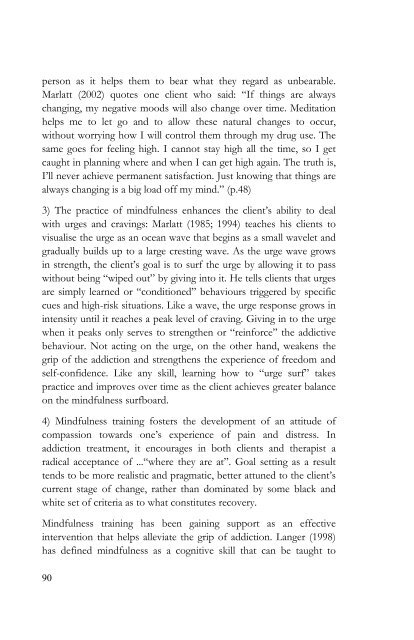Introduction to Mindfulness - Dean Amory
Art and Benefits of Mindfulness Meditation
Art and Benefits of Mindfulness Meditation
You also want an ePaper? Increase the reach of your titles
YUMPU automatically turns print PDFs into web optimized ePapers that Google loves.
person as it helps them <strong>to</strong> bear what they regard as unbearable.<br />
Marlatt (2002) quotes one client who said: “If things are always<br />
changing, my negative moods will also change over time. Meditation<br />
helps me <strong>to</strong> let go and <strong>to</strong> allow these natural changes <strong>to</strong> occur,<br />
without worrying how I will control them through my drug use. The<br />
same goes for feeling high. I cannot stay high all the time, so I get<br />
caught in planning where and when I can get high again. The truth is,<br />
I’ll never achieve permanent satisfaction. Just knowing that things are<br />
always changing is a big load off my mind.” (p.48)<br />
3) The practice of mindfulness enhances the client’s ability <strong>to</strong> deal<br />
with urges and cravings: Marlatt (1985; 1994) teaches his clients <strong>to</strong><br />
visualise the urge as an ocean wave that begins as a small wavelet and<br />
gradually builds up <strong>to</strong> a large cresting wave. As the urge wave grows<br />
in strength, the client’s goal is <strong>to</strong> surf the urge by allowing it <strong>to</strong> pass<br />
without being “wiped out” by giving in<strong>to</strong> it. He tells clients that urges<br />
are simply learned or “conditioned” behaviours triggered by specific<br />
cues and high-risk situations. Like a wave, the urge response grows in<br />
intensity until it reaches a peak level of craving. Giving in <strong>to</strong> the urge<br />
when it peaks only serves <strong>to</strong> strengthen or “reinforce” the addictive<br />
behaviour. Not acting on the urge, on the other hand, weakens the<br />
grip of the addiction and strengthens the experience of freedom and<br />
self-confidence. Like any skill, learning how <strong>to</strong> “urge surf” takes<br />
practice and improves over time as the client achieves greater balance<br />
on the mindfulness surfboard.<br />
4) <strong>Mindfulness</strong> training fosters the development of an attitude of<br />
compassion <strong>to</strong>wards one’s experience of pain and distress. In<br />
addiction treatment, it encourages in both clients and therapist a<br />
radical acceptance of ...“where they are at”. Goal setting as a result<br />
tends <strong>to</strong> be more realistic and pragmatic, better attuned <strong>to</strong> the client’s<br />
current stage of change, rather than dominated by some black and<br />
white set of criteria as <strong>to</strong> what constitutes recovery.<br />
<strong>Mindfulness</strong> training has been gaining support as an effective<br />
intervention that helps alleviate the grip of addiction. Langer (1998)<br />
has defined mindfulness as a cognitive skill that can be taught <strong>to</strong><br />
90

















